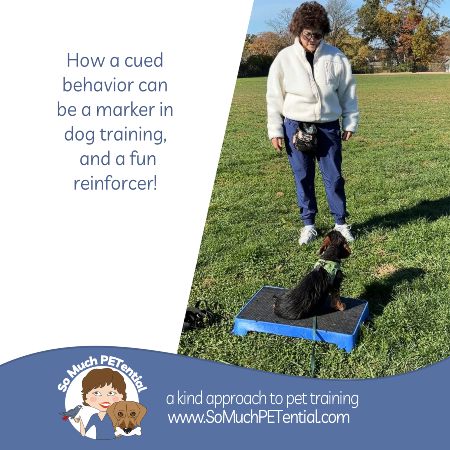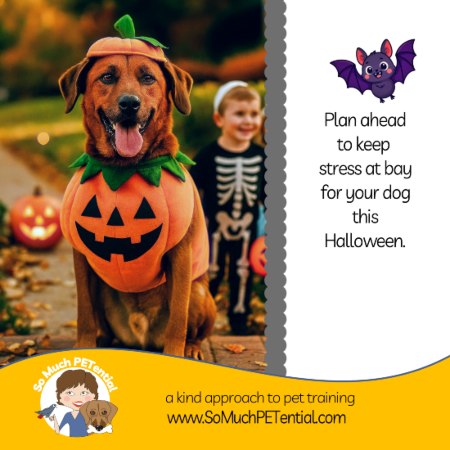Cues and markers can absolutely help you to be a more effective dog trainer for your pet. Here is a training tip on how to use them to create many fun reinforcers.

First, I may confuse you. Did you know that a marker is also a cue, and a cue can be a marker?
Yep, it is true!
Let me first explain the meaning of these two words.
What is a marker for dog training?
A marker is often a distinct sound such as a click, or a word like YES, that is delivered just when your dog or bird or other animal does the specific behavior you want to see. It is followed by something your pet values (a reinforcer) such as a treat.
It can really clear up the lesson for your pet if the marker is delivered with good timing because the quicker the consequence, the quicker your pet can learn the association between the behavior and what he/she gets as a result.
While sounds like YES, GOOD or a click are often used, you also have a whole lot of other options that I will explain below.
What is a cue in dog training?
A cue (also called a discriminative stimulus) is some sort of environmental event that sets the stage for the behavior to occur. It is a sort of Green Light that signals, *at this time*, *if* you do the behavior, *then*, the opportunity for a certain consequence is available.
A cue can come from the environment. As an example, a human picking up the phone is often a cue for a dog to begin attention seeking behaviors because *at that time* attention seeking behaviors have a high predictability of getting a toy, treats, attention.
A cue can also be one that you use in training such as the words sit, come or drop. If your dog sits when you say sit, then your dog may get something else.
In training, keep in mind that it is the CONSEQUENCE of the behavior that actually TEACHES the behavior. The cue only sets the stage for the behavior. Behavior occurs to get a consequence.
Ok, so now that I explained these definitions, how can a marker be a cue and a cue be a marker?
Keep in mind that, being a bridge between the behavior and the reinforcer, the marker is a predictor of good things to come. *IF* a behavior has a high value to the learner (either because it was taught with positive reinforcement or is intrinsically reinforcing), then the opportunity to do THAT behavior can reinforce the behavior you are teaching.
A couple examples of this…my dog loves our SEARCH game. (I say search and toss a treat in a direction.) I have played this game with him probably hundreds of times so it is a super charged game. When I call him inside from our backyard, (I do cheer him on as he is on his way) I mark his coming inside the door by saying SEARCH, and then the reinforcer that follows is a search game of A+ value treats in my living room. Even if he is barking at birds, he will charge to my patio door now.
I also use the SEARCH marker and game if we are passing geese on a walk or he sees a dog from a distance.
Other examples of markers that are cues for high valued reinforcing behaviors are:
BALL – for being tossed a ball
TUG – for a game of tug
TOUCH – for touch my hand with your nose
Before you can use these cues for behaviors as a marker, first practice those cues and behaviors a lot – to the point of fluency. Remember, whether used in the context of teaching another behavior or not, any time you teach anything, repetition is important.
The wonderful aspect of being able to use cues for behaviors as markers for another behavior is it opens up a whole world of choices to use as reinforcers. That makes training so much more fun for the learner!
Location Specific Markers in Dog Training
Another use for this kind of thinking is to use cues to indicate where and how a treat will be delivered. How and where you deliver a treat are valuable in teaching behaviors.
If I am teaching a new behavior such as laying down, I will first (after getting the behavior to happen) deliver multiple treats, one after another, to the dog for being in position. Then I will want him to get up from position to practice getting back into position again. In this instance, I can have a marker that indicates food is coming to you, and a marker that indicates getting a treat that was tossed or moving toward my hand to take a treat.
I am beginning to use these more as I’ve learned how valuable they can be for clarity. Admittedly, I do use GOOD and YES interchangeably for in position and out of position, but I also use other location markers to mean ‘move to the food’. Here are a few examples of common markers if you’d like to try them.
GOOD – food is coming to you
TAKE – come to my hand to get treat
YES – go to the treat
GET IT – go to tossed treat (yes and get it can potentially mean the same thing. It is ok to
have two cues for the same behavior. See this post.)
for the CLICK – I use that to mean treat is available but I do use it to feed in position and
out of position depending on what I am working on
These are easy to teach. Simply say the word and follow it with delivering the treat as you want your dog to understand. Just as with any training, be consistent and make it fun.
If this seems like a lot to learn, just start with teaching a marker that means ‘food is coming to you’ and one that gets your dog out of position like ‘come to your hand’ or ‘get the treat from the ground’.
In the video below, you can see how I first practiced with this German short haired dachshund puppy the cue, TAKE, for come to my hand for the treat. (See how I took a step back and was energetic with my voice too.) Once he showed me he enjoyed that game and was doing it fluently, THEN, I could use it in teaching him to go to the platform.
As you can see there are SO many choices for how your can use these different types of reinforcers to make your training really fun for your dog AND you!






